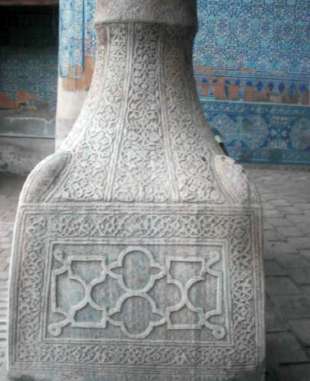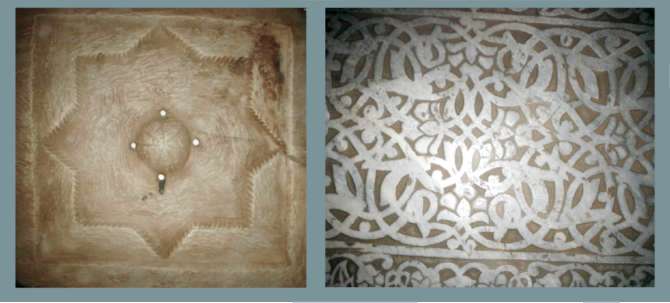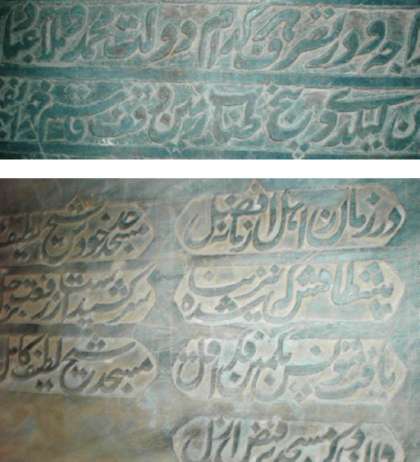 During the archaeological excavations on the territory of Khorezm there were found a lot of statues, different samples of carving the stone of the pre-Islamic period. Still not scientifically proven certain assumptions about the fact, that in the XVI – XX centuries was a tangible the recession of the development of this art form. Even the few samples of archaeological monuments, now stored in the storerooms of museums, clearly prove the rapid flowering of this art form in that period. Masters who worked with the rock, in ancient Khiva called “тоштарош” (uzb. Tosh – stone), “сангтарош” (Tajik sang – stone – masons, gem cutters. “The village, where lived the master thread of marble, was called Sangar. Now he is connected to the city’s territory and is called mahallas Sangar“. Carving in stone and marble often all was used to perpetuate the memory of historical personalities, dates, wills, birth, the family of the data in the necropolises, нагробных plates and elements of paired columns. (Stone structures, columns of stone such as in the countries of Europe and parts of the world, there is no, and we go further on the different sizes and height pedestals, stand-props for wooden columns). Marble appreciated for its physical properties – hardness, the ability to split into thin plates, abrasive the quality. It’s durable, износостоек and unique beauty. Marble stand, Sagan Кухна Arch, Тошховли, Juma the mosque, the mausoleum of Pahlavan Mahmud in Khiva – magnificent works of art of painting on a rock. In Khorezm marble was imported from Karakalpakstan. It came in the mountains Юмуртов, Sultan Uvajs, Carats and used as a the Foundation, предохранявшего building from moisture. From it participants were carved necessary for decoration and construction process the details. Marble decorated unusually delicate vegetative and geometrical patterns, meaningful the text of the letter. Have survived many samples this kind of art. On tomb marble mausoleum Pahlavan Mahmud in Khiva patterns and the texts and visible today clearly – so well they are preserved. Marble recorded the most important events of state importance, date, information on major buildings. Such information contain samples, installed in a niche of the internal the walls of Djuma-mosque, the minaret and madrassah Islamhodgi, in the reception hall of Isfandiar,, madrassah of Yusuf Yasavilbasi and Ibrahimhodgi, in Korihan (educational institution, where she prepared reciters of the Quran). There are some works such Khiva masters as Hudaybergan Muhrkan Hivakiy Muhammad Panels coals (1817 – 1914), Sabirzhan Khudaiberganov, Kamil Devaniy, Karimbergan Rahman coals, X. Rakhimov, V. Davlatov, And. Bekganov To. Palvanov, To. Ruzmatov, etc. In repository and exhibition halls of the State Museum – reserve Ichancola in Khiva is stored 60 exhibits from the marble. This vakfnye of ratification, objects of home utensils (cauldrons, kettles, the upper part of the table) and panels. 45 exhibits are of great historical value (end of the XIX – the beginning XX C.). The remaining 15 exhibits – marble panels made in 1920 -1990, for a variety of architectural structures. Among them – two of the vegetative patterns wizard Karimbergana Rakhmonov. Depending on the purpose of the ancient exhibits of the Fund – articles of stone, can be divided into three groups: marble, used for construction, marble slabs the shrines, household utensils.
During the archaeological excavations on the territory of Khorezm there were found a lot of statues, different samples of carving the stone of the pre-Islamic period. Still not scientifically proven certain assumptions about the fact, that in the XVI – XX centuries was a tangible the recession of the development of this art form. Even the few samples of archaeological monuments, now stored in the storerooms of museums, clearly prove the rapid flowering of this art form in that period. Masters who worked with the rock, in ancient Khiva called “тоштарош” (uzb. Tosh – stone), “сангтарош” (Tajik sang – stone – masons, gem cutters. “The village, where lived the master thread of marble, was called Sangar. Now he is connected to the city’s territory and is called mahallas Sangar“. Carving in stone and marble often all was used to perpetuate the memory of historical personalities, dates, wills, birth, the family of the data in the necropolises, нагробных plates and elements of paired columns. (Stone structures, columns of stone such as in the countries of Europe and parts of the world, there is no, and we go further on the different sizes and height pedestals, stand-props for wooden columns). Marble appreciated for its physical properties – hardness, the ability to split into thin plates, abrasive the quality. It’s durable, износостоек and unique beauty. Marble stand, Sagan Кухна Arch, Тошховли, Juma the mosque, the mausoleum of Pahlavan Mahmud in Khiva – magnificent works of art of painting on a rock. In Khorezm marble was imported from Karakalpakstan. It came in the mountains Юмуртов, Sultan Uvajs, Carats and used as a the Foundation, предохранявшего building from moisture. From it participants were carved necessary for decoration and construction process the details. Marble decorated unusually delicate vegetative and geometrical patterns, meaningful the text of the letter. Have survived many samples this kind of art. On tomb marble mausoleum Pahlavan Mahmud in Khiva patterns and the texts and visible today clearly – so well they are preserved. Marble recorded the most important events of state importance, date, information on major buildings. Such information contain samples, installed in a niche of the internal the walls of Djuma-mosque, the minaret and madrassah Islamhodgi, in the reception hall of Isfandiar,, madrassah of Yusuf Yasavilbasi and Ibrahimhodgi, in Korihan (educational institution, where she prepared reciters of the Quran). There are some works such Khiva masters as Hudaybergan Muhrkan Hivakiy Muhammad Panels coals (1817 – 1914), Sabirzhan Khudaiberganov, Kamil Devaniy, Karimbergan Rahman coals, X. Rakhimov, V. Davlatov, And. Bekganov To. Palvanov, To. Ruzmatov, etc. In repository and exhibition halls of the State Museum – reserve Ichancola in Khiva is stored 60 exhibits from the marble. This vakfnye of ratification, objects of home utensils (cauldrons, kettles, the upper part of the table) and panels. 45 exhibits are of great historical value (end of the XIX – the beginning XX C.). The remaining 15 exhibits – marble panels made in 1920 -1990, for a variety of architectural structures. Among them – two of the vegetative patterns wizard Karimbergana Rakhmonov. Depending on the purpose of the ancient exhibits of the Fund – articles of stone, can be divided into three groups: marble, used for construction, marble slabs the shrines, household utensils.  Among the panels and vakfny of ratification of the most valuable panels on the history of the madrasah Islamhodgi and a panel of poems of the poet Ogahiy (work X. Muhrkana), vakfny of ratification madrasah Fozilbeka, the panel selected poems and panels vakfny of ratification of the lands, issued by the Khorezm khanate in the name of Hodjimahrama. For the scientific study of the present value as well household items – marble cauldrons, jugs, ляганы of different size, ink tank (davla), grain (ugir, haroz), etc. The State Museum-reserve is Ichankala the well preserved tombstones 12 ambassadors, who a significant contribution to the establishment of the armistice with Djunaidhanome (1920), as well as tombstones Isfandiyarhan (XVII century.) and Abdullah Mehtar. Tenderness of the design, composition the construction of the astonished and the panels of the white and black marble, made Cангтарошем Худайберганом Мухрканом. In Khoresm the Department of applied art (madrasah Islamkhoja) and the Department of national Handicrafts (Тошховли) exhibited 15 exhibits of stone carving. Panels poems Arabic handwriting “kufi” poet Ogakha, a tombstone with description of the life Ибрахимаходжи and decorated with vegetable patterns “мадохил”, as well as other panels songs beautiful patterns are bright examples of high-level the development in Khorezm art of carving on the marble. The most common products of stone – cover Adana. In all of the rich families, families with average income and even some representatives of the lower class set marble cover Adana with carved patterns. Sewage network in Ичанкале passed through the whole town and covered the all the houses, therefore each of them installed Adan. In funds of the Museum-reserve is stored 7 covers Adana. They also in the obligatory order are established in all madrasas, mosques, palaces. In the Khorezm Museum-reserve are stored unique the carved designs. One of them – a panel of the Arab alphabet – letters necessary for the publication of books, as well as marble products with smooth polished surface (хароз Toshi, угир). Surface grinding is performed manually. This is a long and exhausting work. Among the exhibits apart it is worth loom of marble. In the Khiva, other than articles, which are in funds of the Museumreserve Ichankali, preserved the foundations of many the houses, built of marble, columns, marble boards and tombstones. Marble for the Foundation – basement of the building, used обтесанный, polished, without a pattern. In the palaces Kahna Arc, Тошховли, Nurullabay, Кибла Тозабог pair columns – marble. On them bears date of completion of construction, the name of the architect, the leading masters of the wise, sayings, poems. Marble panels the Friday mosque and the tombstones the mausoleum of Pahlavan Mahmud – the amazing beauty and the technique of execution the carved designs. Scientist Kamiljan Khudaiberganov devoted many years to the study of epigraphy the ancient architectural structures Khiva. In his work (2) details studied epigraphic sources ancient monuments, analyzed and translated from Arabic to Uzbek all the inscriptions. Kamiljan Khudaiberganov read and
Among the panels and vakfny of ratification of the most valuable panels on the history of the madrasah Islamhodgi and a panel of poems of the poet Ogahiy (work X. Muhrkana), vakfny of ratification madrasah Fozilbeka, the panel selected poems and panels vakfny of ratification of the lands, issued by the Khorezm khanate in the name of Hodjimahrama. For the scientific study of the present value as well household items – marble cauldrons, jugs, ляганы of different size, ink tank (davla), grain (ugir, haroz), etc. The State Museum-reserve is Ichankala the well preserved tombstones 12 ambassadors, who a significant contribution to the establishment of the armistice with Djunaidhanome (1920), as well as tombstones Isfandiyarhan (XVII century.) and Abdullah Mehtar. Tenderness of the design, composition the construction of the astonished and the panels of the white and black marble, made Cангтарошем Худайберганом Мухрканом. In Khoresm the Department of applied art (madrasah Islamkhoja) and the Department of national Handicrafts (Тошховли) exhibited 15 exhibits of stone carving. Panels poems Arabic handwriting “kufi” poet Ogakha, a tombstone with description of the life Ибрахимаходжи and decorated with vegetable patterns “мадохил”, as well as other panels songs beautiful patterns are bright examples of high-level the development in Khorezm art of carving on the marble. The most common products of stone – cover Adana. In all of the rich families, families with average income and even some representatives of the lower class set marble cover Adana with carved patterns. Sewage network in Ичанкале passed through the whole town and covered the all the houses, therefore each of them installed Adan. In funds of the Museum-reserve is stored 7 covers Adana. They also in the obligatory order are established in all madrasas, mosques, palaces. In the Khorezm Museum-reserve are stored unique the carved designs. One of them – a panel of the Arab alphabet – letters necessary for the publication of books, as well as marble products with smooth polished surface (хароз Toshi, угир). Surface grinding is performed manually. This is a long and exhausting work. Among the exhibits apart it is worth loom of marble. In the Khiva, other than articles, which are in funds of the Museumreserve Ichankali, preserved the foundations of many the houses, built of marble, columns, marble boards and tombstones. Marble for the Foundation – basement of the building, used обтесанный, polished, without a pattern. In the palaces Kahna Arc, Тошховли, Nurullabay, Кибла Тозабог pair columns – marble. On them bears date of completion of construction, the name of the architect, the leading masters of the wise, sayings, poems. Marble panels the Friday mosque and the tombstones the mausoleum of Pahlavan Mahmud – the amazing beauty and the technique of execution the carved designs. Scientist Kamiljan Khudaiberganov devoted many years to the study of epigraphy the ancient architectural structures Khiva. In his work (2) details studied epigraphic sources ancient monuments, analyzed and translated from Arabic to Uzbek all the inscriptions. Kamiljan Khudaiberganov read and  translated text carved in the marble portal madrasah Мухаммаднияза Деванбеги, verses of the poet Ogakha, carved out on the column aivan Кухна of the Arc, the characters the Board, installed on the front the door madrasah Мухаммадхана Рахимха at the II, the text of vakfnoy of ratification madrasah Shergazikhan, ode on a panel at the mausoleum Pahlavan Mahmud, the lyrics are in marble the Board, installed above the door Кариханы, inscriptions on the tombstones plates Абдулгази, of anushakhan, Арангхана, Латифаханум, Оталика Тангрикули, panels madrasah Исламаходжи, the marble plates the minaret, the mosque Богбонли, mosques Bob Harris and Juma, in niche-altar in the the inner wall of the mosque, indicating the direction of in Mecca in the madrassah of Muhammad Yusuf Ясаулбаши, the mausoleum of Uch авлие, columns Тошховли. On the marble of the madrasah Хужамбердибия, Palvan Measles, the mausoleum of Saida Moha Rui Жахана, the Palace of Нуруллабая, Киблы Тозабага, cemeteries Shokhi- mardanbabi, etc. In the process of reading a book (2), where in the application are given the illustrations of the carved images of original texts, we discovered the new names of the masters, the date of the structures of archaeological monuments of those, who sponsored the construction. The majority of the marble panels with the Arabic alphabet and the text in Persian, Turkish and Uzbek languages sent handwriting “насталик”, the Shrine – in handwriting “таълик”. On the marble carved the historical date, the chants, poems and odes. In Khorezm used white and black marble. Sometimes meets and grey (the Shrine of Арангхон, Латифаханум, Аталик Тангрикули). Marble tiles-panels with plant and geometrical patterns on the edges and with a letter in the middle of installed over the main door or on the side of the casing. Thus, in the XVII – XX centuries in Khorezm art processing marble was engaged in a whole galaxy of skilful masters- stone-cutters. Patterns on products from a white marble covered by the black paint, to emphasize its beauty and clearly were visible inscription when reading from a distance.
translated text carved in the marble portal madrasah Мухаммаднияза Деванбеги, verses of the poet Ogakha, carved out on the column aivan Кухна of the Arc, the characters the Board, installed on the front the door madrasah Мухаммадхана Рахимха at the II, the text of vakfnoy of ratification madrasah Shergazikhan, ode on a panel at the mausoleum Pahlavan Mahmud, the lyrics are in marble the Board, installed above the door Кариханы, inscriptions on the tombstones plates Абдулгази, of anushakhan, Арангхана, Латифаханум, Оталика Тангрикули, panels madrasah Исламаходжи, the marble plates the minaret, the mosque Богбонли, mosques Bob Harris and Juma, in niche-altar in the the inner wall of the mosque, indicating the direction of in Mecca in the madrassah of Muhammad Yusuf Ясаулбаши, the mausoleum of Uch авлие, columns Тошховли. On the marble of the madrasah Хужамбердибия, Palvan Measles, the mausoleum of Saida Moha Rui Жахана, the Palace of Нуруллабая, Киблы Тозабага, cemeteries Shokhi- mardanbabi, etc. In the process of reading a book (2), where in the application are given the illustrations of the carved images of original texts, we discovered the new names of the masters, the date of the structures of archaeological monuments of those, who sponsored the construction. The majority of the marble panels with the Arabic alphabet and the text in Persian, Turkish and Uzbek languages sent handwriting “насталик”, the Shrine – in handwriting “таълик”. On the marble carved the historical date, the chants, poems and odes. In Khorezm used white and black marble. Sometimes meets and grey (the Shrine of Арангхон, Латифаханум, Аталик Тангрикули). Marble tiles-panels with plant and geometrical patterns on the edges and with a letter in the middle of installed over the main door or on the side of the casing. Thus, in the XVII – XX centuries in Khorezm art processing marble was engaged in a whole galaxy of skilful masters- stone-cutters. Patterns on products from a white marble covered by the black paint, to emphasize its beauty and clearly were visible inscription when reading from a distance.
Masharib Abdullaev
